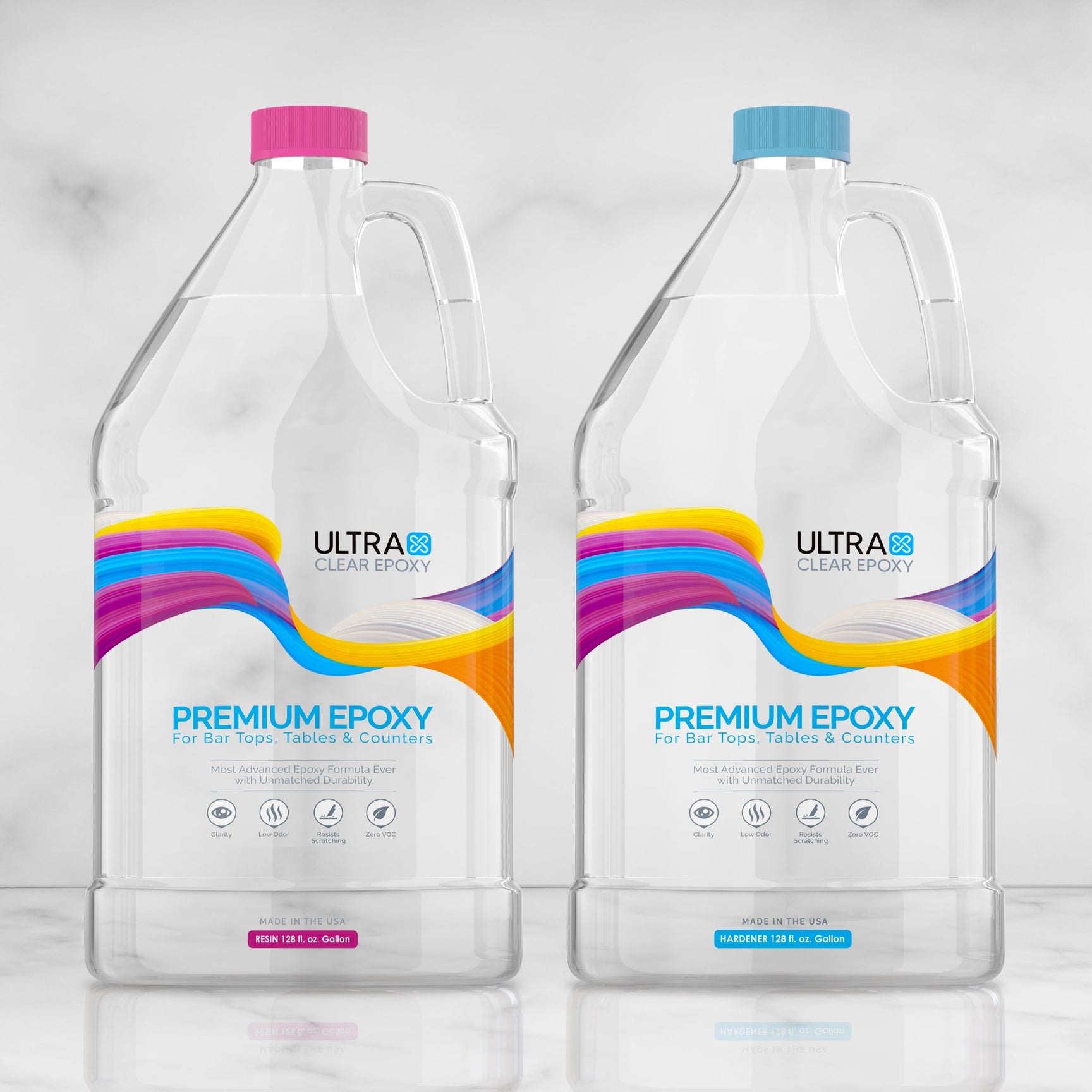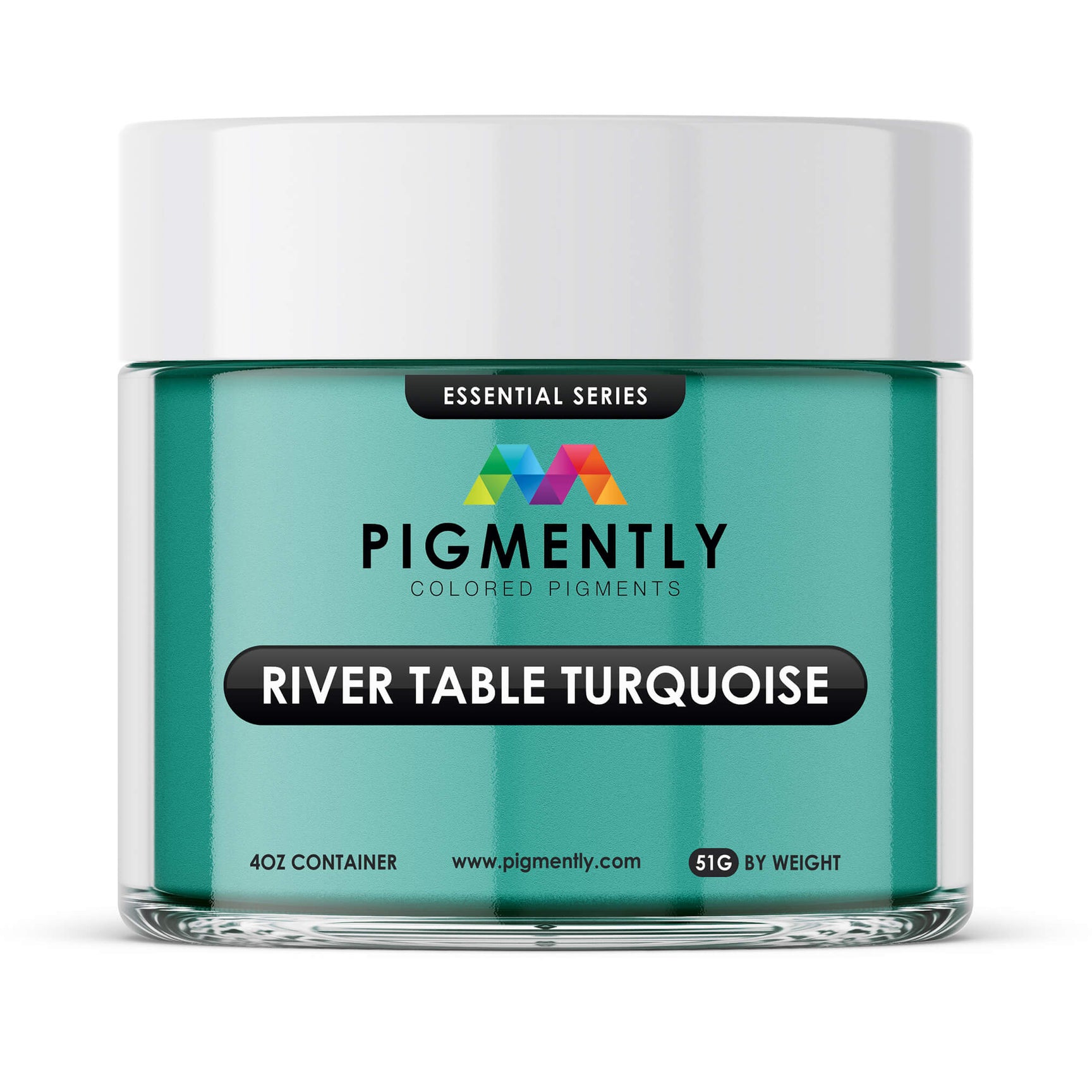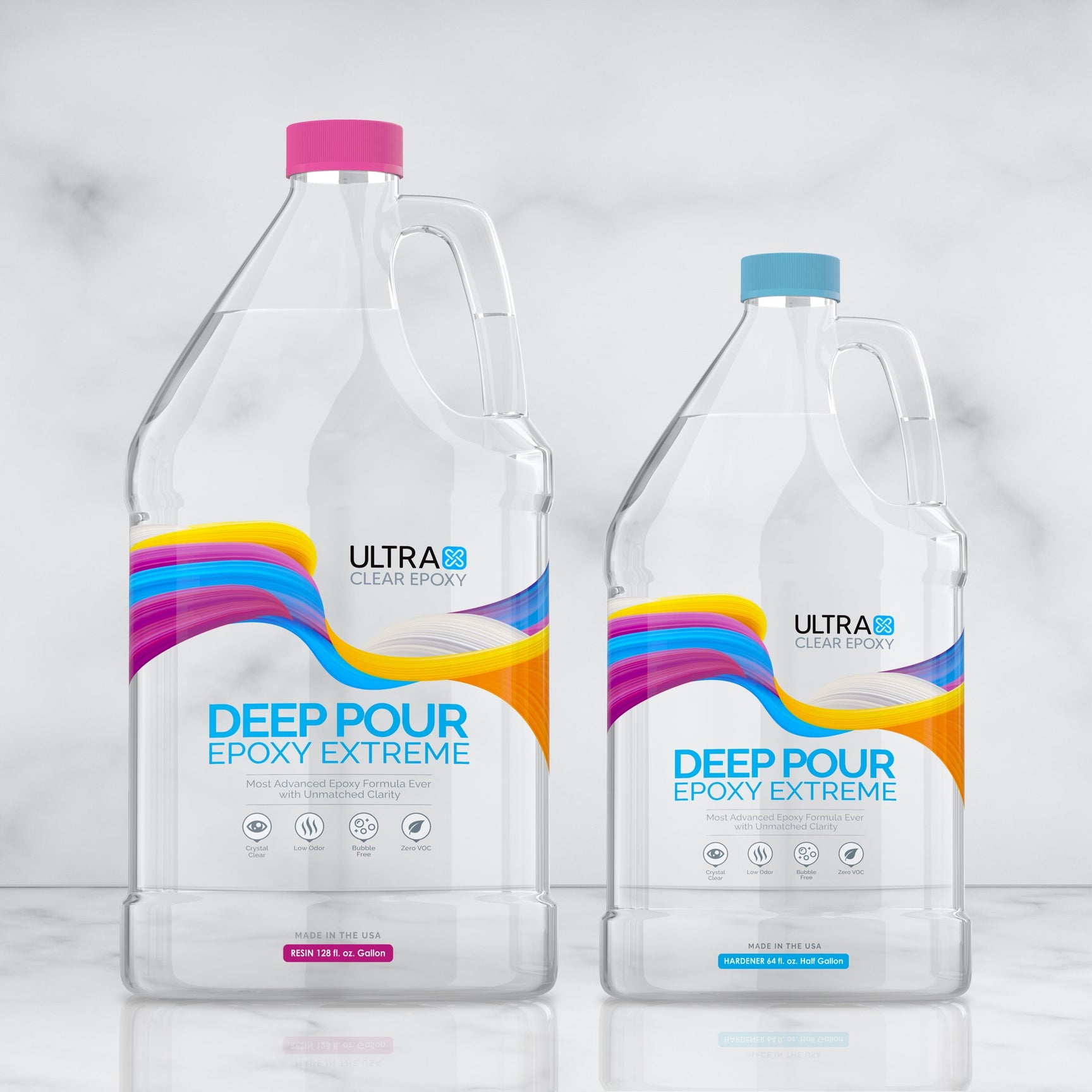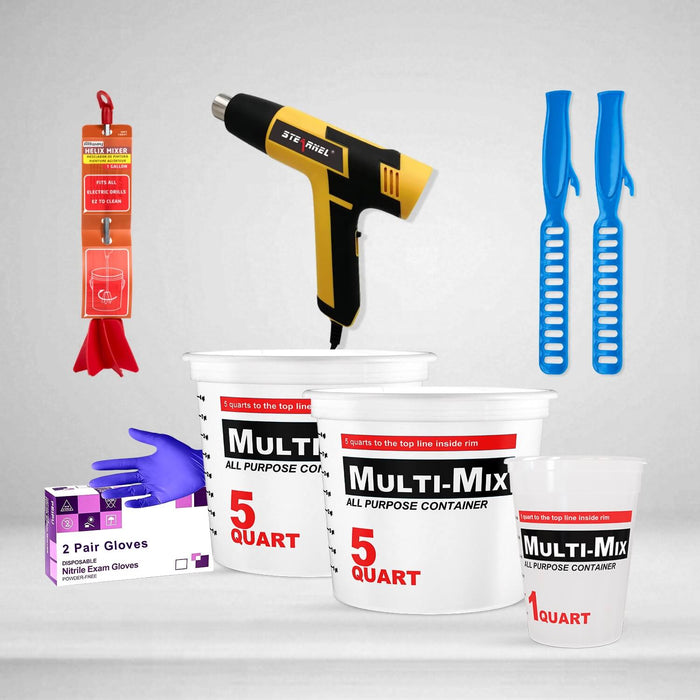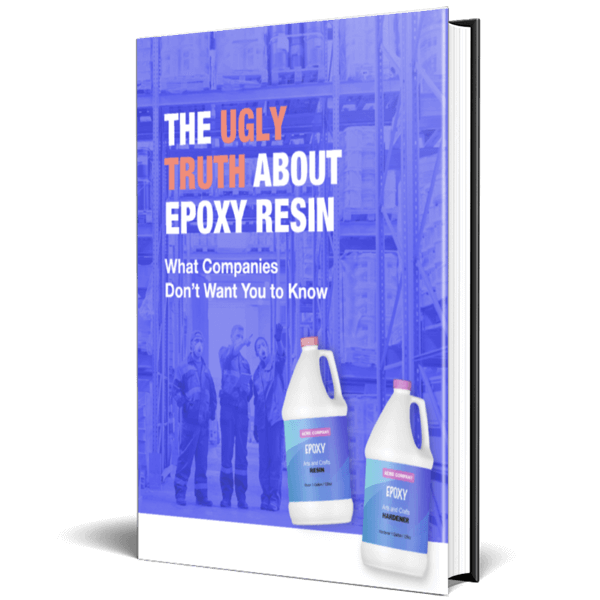Epoxy has a reputation for being an ideal finish for countertops, table tops, bar tops, and other types of decorative furniture. It's durable, attractive, and—with proper care—able to last for many years.
But how long does it actually last? And which factors influence the lifespan of an epoxy resin finish?
Today we'll explain how to get the most out of your epoxy resin by providing tips on care along with our resin recommendations for various types of epoxy projects.
How long does epoxy last?
Five key factors affect how long an epoxy finish or resin art piece will remain in peak condition before it begins to gradually deteriorate (which can be avoided through refreshing your finish with a new coat).
The Five Key Factors for epoxy lifespan are:
- The brand of epoxy you use: Generally, premium brands will last longer than unfamiliar off-brands.
- The type of epoxy you use: Epoxy resin comes in different types, suited for different projects. For instance, table top epoxies are designed to last the longest and withstand the most stress and wear. However, they can't be applied in thick layers and require more work when a thick layer is needed.
- The climate conditions when the epoxy is curing or being mixed: For epoxy to fully harden, it needs to be in its ideal range for temperature and humidity.
- The care put into mixing, pouring, and air bubble removal: Each step of the epoxy process is essential to getting the most out of your resin. If any steps aren't handled properly, the epoxy may have imperfections that mar its appearance or weaken the strength of its surface or substrate bond.
- The environment it's left in: For example, an indoor epoxy table top is likely to last longer than an outdoor epoxy table top that gets consistent exposure to direct sunlight and inclement weather. This will affect the visual appearance first, and eventually the physical smoothness/surface strength as well.

Understanding the state of epoxy as a commodity
The first thing that's going to affect your project lifetime will be your choice of epoxy resin. These days, there are thousands of resin brands available through online marketplaces. Unfortunately, many of them are sourced from nations without reasonable safety standards or quality assurance.
Because the ability to import epoxy resin into the USA is so poorly regulated, many low-quality resins end up being distributed and sold in America without consumer awareness.
This practice has led to many epoxy resin newcomers being soured on the experience because a poor-quality product led to them giving up in frustration and losing money on resin project that ended in failure.
Needless to say, if you find yourself with a high-quality epoxy brand from a reputable dealer, you can expect a much better outcome.

Factor #1: Which epoxy resin brands last the longest?
At UltraClear Epoxy, we offer only premium epoxy resins. Our epoxies have professional-grade quality but are designed to be usable by beginners as well. Each of our resins will last a minimum of 7 years with proper care.
Our resins are also easy to refresh, so if you reach a point at which your epoxy surface needs a touch-up, you can add a new coat of UltraClear Table Top Epoxy to make your surface look good as new.
Most other reputable resin brands should last for at least 5 years—again with proper care—before needing to be refreshed.
The important thing is to avoid unfamiliar brands, especially those sold by 3rd-parties on open marketplaces such as Amazon, eBay, etc. Those are the types of resin that can fail sooner than they should.
Factor #2: Which types of epoxy last the longest?
This is the least influential factor of the five. Each epoxy type will last about the same length if treated properly. The ways in which they differ after curing are primarily in their hardness and ability to withstand certain types of environments.
At UltraClear Epoxy, we currently have 3 premium epoxy types:
- UltraClear Table Top Epoxy - Our strongest epoxy. This is the one you want for a long-lasting finish on non-marine (aquatic) project types. Things like epoxy countertops, table tops, bar tops, large artwork, trays, and more are all ideal for Table Top Epoxy.
- UltraClear Deep Pour Epoxy - Our deep pour casting resin. This is our thick-layer epoxy. It supports 2-inch individual layers, making it perfect for river tables, casting molds, pure epoxy table tops (i.e. table tops made solely with epoxy and no substrate such as wood), and many types of resin jewelry and art.
-
UltraClear Marine Epoxy - Our marine epoxy resin. This is solely designed for aquatic applications, such as for use in composite material layups plus as a finish for kayaks, paddles, boats and their related accessories, as well as many other types of watercraft.
Marine epoxy is a niche resin that can be combined with three different hardeners determined by the climate where the application is taking place.
While other brands may have their own names for these types of resin, the uses are the same. When choosing an epoxy resin, make sure to choose the right type for your project.
Note: For Deep Pour Resin projects, some users like to apply a final topcoat of Table Top Epoxy to give their project (e.g., a river table) the strongest possible finish.
Factor #3: What climate conditions allow epoxy to fully harden?
The ideal temperature range varies by epoxy type:
- For UltraClear Table Top Epoxy: 70°F to 80°F, with 75°F being ideal.
- For UltraClear Deep Pour Epoxy: 60°F to 85°F
- For UltraClear Marine Epoxies: Varies based on hardener type. See each marine hardener page for more details.
As for humidity levels, a relative humidity at or below 60% is good for the mixing phase and curing phase. With marine epoxy, it can vary greatly due to the type of environment they're applied in. For more details, see our marine epoxy product pages.
Epoxy resin that is forced to cure outside these ideals isn't necessarily going to fail (it depends on how far it was from these recommended conditions), but it may take much longer to fully harden, even months. Until that time, it will be in a weaker state that is more susceptible to damage from casual use such as scratching or denting.
Try to give your epoxy project the best environment for curing. In cooler areas, you can use indoor central heating or portable space heaters with a temporary enclosure to maintain the recommended temperatures.
For high humidity, you can use a dehumidifier in the project area.

Factor #4: How does the epoxy process affect a project's lifespan?
How well you perform each step of the epoxy process will determine how good your finish looks and how well it will hold up years later.
Generally, there are 4 or 5 primary steps in a typical epoxy project:
-
The seal coat step - Seal coats are thin epoxy coats that are brushed on by hand to prepare a substrate for a flood coat. A proper seal coat will fill in microscopic holes in the substrate's material and push air out of them. This prevents the air from forming bubbles in your flood coat later.
Click here to learn effective guidelines for applying an epoxy seal coat. -
The flood coat mixing step - This is when you mix up a larger batch of epoxy to pour on as a flood coat. Proper mixing includes careful manual stirring, sometimes with the aid of a power drill (and appropriate drill bit) to ensure a smooth blend.
Click here to learn more about measuring and mixing epoxy. -
The pouring step - Pouring epoxy is relatively easy, due to its ability to self-level. The important part is to not pour a layer that's too thick, which can trap in air bubbles, and to not pour too quickly, which can capture air as the resin falls and settles.
Click here to learn the proper techniques for pouring epoxy. -
The air bubble removal step - This step involves using a heat gun or propane torch to remove air bubbles as they surface in the flood coat. The heat from the tool will release the air and allow the epoxy to finish settling so it can cure properly.
Click here to learn more about air bubbles and how to prevent/remove them. -
The curing step - This is the simplest part of the process. Most epoxy projects will take about 72 hours to properly cure. The only things you need to do during this period are maintaining the appropriate temperatures and making sure nothing disturbs the epoxy project—in other words, keep pets and children away from the area.
Other than that, curing doesn't require any additional interaction.
Following the instructions included with your epoxy is essential to achieving an optimal result for your project. As long as you follow these guidelines as you perform each step, your epoxy project should turn out great.
Factor #5: How does environment affect a finished epoxy project?
Epoxy can be affected negatively by several different environmental factors.
The first is direct sunlight. When epoxy is exposed to direct sunlight over a long period of time, the finish will gradually begin to yellow. Sadly, there's no way to fully prevent this; however, you can mitigate this issue in different ways.
Indoor projects can be positioned away from windows that regularly let in direct sunlight.
For epoxy projects intended to be left outside, try to place them in a shaded area that disperses or obstructs sunlight. An outdoor epoxy table top, for example, can be placed near walls or trees, or be given shade via either a patio umbrella or a shade shelter.
The second environmental factor is exposure to inclement weather. An outdoor project will be susceptible to rain, snow, and other events such as seasonal pollen.
For the most part, these things won't have affect epoxy in a significant way. Epoxy surfaces can be easily cleaned with basic soap and warm water, so as long as you give your finish a decent wash on occasion, you won't have to worry about damage from these elements.
Some final remarks
Epoxy as a surface material is one of the most resilient around. Its only notable weakness is a relatively low heat resistance.
Temperatures of 150°F or greater can cause heat damage to epoxy. Prolonged exposure to temperatures of 135°F can cause the epoxy to soften.
Other than that one caveat, it's incredibly durable. Epoxy is waterproof, chemical resistant, scratch resistant, impact resistant, and ultra smooth—meaning it won't absorb or retain residues or stains from spills.
With proper care, a premium epoxy finish will last you a very long time.

Additional Resources
Here are a few additional resources you may find useful:
- Epoxy: Proper storage, shelf life, and preventing "yellowing" - Our guide to storing epoxy resin, whether opened or sealed.
- Epoxy for beginners: Basic project tools and supplies - A briefing on the tools and supplies needed for typical epoxy projects.
- How to color epoxy - Our guide to using epoxy pigments and resin dyes to give your finish a stunning infusion of color.
Have questions? Want advice? Contact us!
At UltraClear Epoxy, we strive to provide the best experience for our users. Our focus on customer satisfaction is one of our highest priorities. If you have any questions about epoxy resin or would like project planning advice, please reach out to us.
You can contact us via phone or email here. During business hours, you can also text chat online with one of our epoxy experts by clicking the Help button at the bottom right of your screen.
And if you're new to UltraClear Epoxy or epoxy in general and would like to see what it's all about, our UltraClear Table Top Epoxy is a great place to start.
UltraClear Epoxy—Trusted by over 1 Million+ Happy Customers


